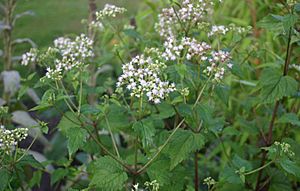White snakeroot facts for kids
Quick facts for kids White snakeroot |
|
|---|---|
 |
|
| Conservation status | |
| Scientific classification | |
 |
|
| Natural range in North America | |
| Synonyms | |
|
The Ageratina altissima, often called white snakeroot, is a plant that can be harmful. It is a perennial herb, meaning it lives for more than two years and has soft, green stems. This plant is part of the Asteraceae family, which includes daisies and sunflowers. You can find it growing naturally in eastern and central North America.
This plant used to be known by a different scientific name, Eupatorium rugosum. However, scientists who study plants, called botanists, have changed how they classify many plants. So, white snakeroot was moved to a new group.
White snakeroot plants grow straight up, sometimes reaching about 1.5 meters (5 feet) tall. They form clumps with one or many stems in the late summer and fall. Their flowers are a bright white color. After the flowers bloom, they release small seeds with fluffy white tails. These tails help the seeds float away in the wind.
You can find white snakeroot in forests and bushy areas. It blooms from mid-summer to late fall. This plant can grow well in different places. It likes shady spots with open ground. It can even become a common plant in shady gardens and along hedges. There are two main types of white snakeroot: Ageratina altissima var. altissima and Ageratina altissima var. roanensis. The second type is also called Appalachian white snakeroot. They are slightly different in their flower parts.
What Makes White Snakeroot Dangerous?
White snakeroot contains a harmful substance called tremetol. When animals like cattle eat these plants, the tremetol gets into their meat and milk. If people then eat the meat or drink the milk from these animals, they can get sick. This sickness is called tremetol poisoning.
If someone consumes enough of the toxin, they can become very ill. This poisoning is also known as milk sickness. In the past, people often got sick by drinking milk from cows that had eaten white snakeroot. Even if the plant is dried and stored for a long time, its harmful properties remain.
In the early 1800s, many European settlers moved to the Midwest and Upper South. They did not know about white snakeroot. Because of this, thousands of people became sick and died from milk sickness. A famous person who might have died from milk sickness in 1818 was Nancy Lincoln, who was the mother of Abraham Lincoln.
It took many years for people to figure out that white snakeroot was the cause. However, a doctor named Anna Pierce Hobbs Bixby is given credit for identifying the plant in the 1830s. It is said that a woman from the Shawnee Tribe taught her about the plant's harmful effects. The Shawnee people had a lot of knowledge about the plants in their area.
Besides cattle, white snakeroot is also harmful to horses, goats, and sheep. Animals that have eaten the plant may show signs of poisoning. These signs include feeling sad and tired, having a runny nose, and drooling a lot. Horses, goats, and cattle might stand with their back legs close together. Sheep might stand with their legs far apart. Animals might also have an arched back and breathe quickly or with difficulty.
Some people believe this plant might have helpful uses too. A tea made from the root has been used to help with diarrhea, kidney stones, and fever. A poultice (a soft, moist mass) made from the root can be put on snakebites.
Growing White Snakeroot
There is a special type of white snakeroot called Eupatorium rugosum 'Chocolate'. Gardeners grow this type because its leaves have a dark color, like chocolate. The leaves become the darkest, almost black, when the plant grows in a sunny spot. These plants can also grow in shady areas and prefer moist soil. More recently, this plant is sold under its correct scientific name.
What Does the Name Mean?
The name Ageratina comes from a Greek word that means 'un-aging'. This refers to how the flowers keep their color for a long time. An ancient Greek doctor named Dioscorides used this name for different plants.
The word Altissima means "the tallest." This probably means that white snakeroot is the tallest plant in its group.



